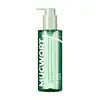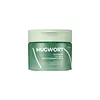What's inside
What's inside
 Key Ingredients
Key Ingredients

 Benefits
Benefits

 Concerns
Concerns

 Ingredients Side-by-side
Ingredients Side-by-side

Ethylhexyl Palmitate
EmollientCetyl Ethylhexanoate
EmollientSorbeth-30 Tetraoleate
EmulsifyingSorbitan Sesquioleate
EmulsifyingEthylhexylglycerin
Skin ConditioningSimmondsia Chinensis Seed Oil
EmollientCannabis Sativa Seed Oil
EmollientNageia Nagi Seed Oil
AntiseborrhoeicVitis Vinifera Seed Oil
EmollientSesamum Indicum Seed Oil
EmollientPrunus Amygdalus Dulcis Oil
Skin ConditioningThymus Zygis Flower Oil
MaskingUlmus Davidiana Root Extract
Skin ConditioningSqualane
EmollientMelaleuca Alternifolia Leaf Extract
PerfumingRosa Indica Flower Extract
AntioxidantWater
Skin ConditioningActinidia Chinensis Fruit Extract
EmollientPhormium Tenax Leaf Water
AntioxidantButylene Glycol
HumectantChamomilla Vulgaris Extract
Skin ProtectingOcimum Basilicum Leaf Extract
Skin ConditioningGlyceryl Glucoside
HumectantCarum Carvi Seed Oil
MaskingLac Powder
Skin ConditioningVateria Indica Bark Extract
AntioxidantSolanum Melongena Fruit Extract
Skin ConditioningMelaleuca Alternifolia Leaf Oil
AntioxidantCallitris Columellaris Leaf/Wood Extract
AntioxidantGlycerin
Humectant1,2-Hexanediol
Skin ConditioningTriticum Vulgare Germ Extract
Skin ConditioningCentella Asiatica Extract
CleansingEthylhexyl Palmitate, Cetyl Ethylhexanoate, Sorbeth-30 Tetraoleate, Sorbitan Sesquioleate, Ethylhexylglycerin, Simmondsia Chinensis Seed Oil, Cannabis Sativa Seed Oil, Nageia Nagi Seed Oil, Vitis Vinifera Seed Oil, Sesamum Indicum Seed Oil, Prunus Amygdalus Dulcis Oil, Thymus Zygis Flower Oil, Ulmus Davidiana Root Extract, Squalane, Melaleuca Alternifolia Leaf Extract, Rosa Indica Flower Extract, Water, Actinidia Chinensis Fruit Extract, Phormium Tenax Leaf Water, Butylene Glycol, Chamomilla Vulgaris Extract, Ocimum Basilicum Leaf Extract, Glyceryl Glucoside, Carum Carvi Seed Oil, Lac Powder, Vateria Indica Bark Extract, Solanum Melongena Fruit Extract, Melaleuca Alternifolia Leaf Oil, Callitris Columellaris Leaf/Wood Extract, Glycerin, 1,2-Hexanediol, Triticum Vulgare Germ Extract, Centella Asiatica Extract
Cetyl Ethylhexanoate
EmollientCaprylic/Capric Triglyceride
MaskingEthylhexyl Palmitate
EmollientPEG-20 Glyceryl Triisostearate
EmollientSynthetic Wax
AbrasivePEG-10 Isostearate
EmulsifyingSorbitan Sesquioleate
EmulsifyingCI 77288
Cosmetic ColorantCaprylyl Glycol
EmollientCI 77499
Cosmetic ColorantJuglans Regia Seed Oil
Skin ConditioningHelianthus Annuus Seed Oil
EmollientVitis Vinifera Seed Oil
EmollientIndigofera Tinctoria Extract
MaskingEthylhexylglycerin
Skin ConditioningPrunus Amygdalus Dulcis Oil
Skin ConditioningOenothera Biennis Oil
EmollientSimmondsia Chinensis Seed Oil
EmollientArtemisia Princeps Leaf Water
MaskingWater
Skin ConditioningButylene Glycol
HumectantPhytosterols
Skin ConditioningPanthenol
Skin ConditioningMelaleuca Alternifolia Leaf Oil
AntioxidantCapryloyl Salicylic Acid
ExfoliatingCitric Acid
BufferingSalicylic Acid
MaskingArtemisia Vulgaris Oil
PerfumingGluconolactone
Skin ConditioningArtemisia Argyi Leaf Extract
Skin Conditioning1,2-Hexanediol
Skin ConditioningSodium Hyaluronate
HumectantHydrolyzed Hyaluronic Acid
HumectantSodium Acetylated Hyaluronate
HumectantCetyl Ethylhexanoate, Caprylic/Capric Triglyceride, Ethylhexyl Palmitate, PEG-20 Glyceryl Triisostearate, Synthetic Wax, PEG-10 Isostearate, Sorbitan Sesquioleate, CI 77288, Caprylyl Glycol, CI 77499, Juglans Regia Seed Oil, Helianthus Annuus Seed Oil, Vitis Vinifera Seed Oil, Indigofera Tinctoria Extract, Ethylhexylglycerin, Prunus Amygdalus Dulcis Oil, Oenothera Biennis Oil, Simmondsia Chinensis Seed Oil, Artemisia Princeps Leaf Water, Water, Butylene Glycol, Phytosterols, Panthenol, Melaleuca Alternifolia Leaf Oil, Capryloyl Salicylic Acid, Citric Acid, Salicylic Acid, Artemisia Vulgaris Oil, Gluconolactone, Artemisia Argyi Leaf Extract, 1,2-Hexanediol, Sodium Hyaluronate, Hydrolyzed Hyaluronic Acid, Sodium Acetylated Hyaluronate
Ingredients Explained
These ingredients are found in both products.
Ingredients higher up in an ingredient list are typically present in a larger amount.
1,2-Hexanediol is a synthetic liquid and another multi-functional powerhouse.
It is a:
- Humectant, drawing moisture into the skin
- Emollient, helping to soften skin
- Solvent, dispersing and stabilizing formulas
- Preservative booster, enhancing the antimicrobial activity of other preservatives
Butylene Glycol (or BG) is used within cosmetic products for a few different reasons:
Overall, Butylene Glycol is a safe and well-rounded ingredient that works well with other ingredients.
Though this ingredient works well with most skin types, some people with sensitive skin may experience a reaction such as allergic rashes, closed comedones, or itchiness.
Learn more about Butylene GlycolCetyl Ethylhexanoate is an emollient ester. It comes from cetearyl alcohol and 2-ethylhexanoic acid.
Cetyl Ethylhexanoate is an emollient that adds a velvety feel to skin without being greasy or oily. Emollients help trap moisture into your skin, keeping your skin soft and hydrated.
Ethylhexyl Palmitate, also known as octyl palmitate, is created from 2-ethylhexyl alcohol and palmitic acid. It is a fatty acid ester.
The fatty acid content of Ethylhexyl Palmitate makes it an emollient. Emollients help soften and hydrate your skin by trapping moisture within.
Ethylhexyl Palmitate is also used to help improve the texture of cosmetics. It helps other ingredient dissolve in products and help disperse ingredients more evenly.
You'll likely find this ingredient in sunscreen, as it is often used to mix UV-blocking ingredients such as avobenzone and ethylhexyl triazone.
It can also help stabilize the fragrances in a product as a fragrance fixative.
Ethylhexyl Palmitate can be used to substitute mineral oil.
Due to its high fatty acid content, it may not be fungal-acne safe.
Learn more about Ethylhexyl PalmitateEthylhexylglycerin (we can't pronounce this either) is commonly used as a preservative and skin softener. It is derived from glyceryl.
You might see Ethylhexylglycerin often paired with other preservatives such as phenoxyethanol. Ethylhexylglycerin has been found to increase the effectiveness of these other preservatives.
This tea tree oil comes from the leaves of the Tea Tree plant. Tea tree oil has antioxidant, anti-inflammatory, and antimicrobial properties.
According to the book Journal of Profiles of Drug Substances, tea tree helps in reducing acne-causing bacteria such as Propionibacterium acnes. This is due to the Terpinen components of tea tree oil.
Tea tree may cause sensitivity and irritation for some people. This oil naturally contains fragrance such as linalool and limonene.
However, research shows irritation usually occurs when using pure tea tree oil and not in cosmetic products.
Tea tree oil was found to help relieve the symptoms of psoriasis in one study.
Tea tree oil is toxic when ingested. Another study showed it to caused damage to the nervous system of dogs and cats when applied to their skin or given orally.
Learn more about Melaleuca Alternifolia Leaf OilPrunus Amygdalus Dulcis Oil comes from the sweet almond, a tree native to Iran. This oil has no fragrance and is non-volatile.
Almonds contain healthy fats, vitamins, and minerals. It is a rich source of Vitamin E, a great antioxidant and skin conditioning ingredient. Sweet almond oil contains fatty acids such as linolenic acid and triglycerides.
The content of sweet almond oil makes it a great emollient; it can help soften and hydrate your skin. Emollients create a barrier over your skin to trap moisture in. Sweet almond oil has antioxidant properties.
Those with an almond allergy should be careful of this ingredient and speak with a professional about using it in your skincare.
This ingredient may not be fungal-acne safe.
Learn more about Prunus Amygdalus Dulcis OilThis oil comes from the seeds of the desert shrub called Jojoba. It is more commonly known as jojoba oil, a non-comedogenic oil.
Jojoba oil does not contain fragrance and has many fatty-acids, making it a great soothing ingredient.
It also contains Vitamin E, a great moisturizing ingredient. Vitamin E is also an antioxidant and protects your skin against oxidative damage.
This ingredient humectant properties, meaning it helps draw moisture from the air. This helps keep your skin hydrated.
While jojoba has antibacterial properties, it is only able to kill some strains of bacteria.
Studies also show it helps in wound healing. In fact, Indigenous cultures have used jojoba as a moisturizer and to help treat burns for centuries.
Fun fact: Jojoba oil similar to natural human skin sebum, so it has a great effect on dry skin. It is also promising with helping to regulate sebum production.
Due to its fatty acid content, Jojoba oil may not be fungal acne safe. We recommend speaking with a professional if you have any concerns.
Learn more about Simmondsia Chinensis Seed OilSorbitan Sesquioleate is derived from sorbitol and oleic acid. It is an emulsifier and prevents ingredients from separating.
Specifically, this ingredient is a water-in-oil emulsifier, meaning it helps water dissolve into oil.
Some studies suggest this ingredient may cause irritation in some people. If you are unsure, it is best to patch test.
This ingredient may not be Malassezia folliculitis, or fungal-acne safe.
Learn more about Sorbitan SesquioleateVitis Vinifera Seed Oil comes from the grape vine. Grape seeds are a byproduct of creating grape juice or wine.
The components of grape seeds have many skin benefits. Research has found it to be antimicrobial and anti-inflammatory. It also contains many potent antioxidants such as Vitamin E , Vitamin C, proanthocyanidins, polyphenols, flavonoids, and anthocyanins. Proanthocyanidin has been shown to help even out skin tone.
Antioxidants help fight free-radical molecules. Free-radical molecules are capable of damaging our cells and other genetic material. Antioxidants help stabilize free-radicals by donating extra electrons. Grape seed extract may help reduce the signs of aging.
The antimicrobial properties of grape seed may help treat acne. However, more research is needed to support this claim.
Grape seed has also been found to help absorb UV rays. Grape seed extract should not replace your sunscreen.
The fatty acids of grape seed oil give it emollient properties. Emollients help soothe and soften your skin by creating a film. This film traps moisture within, keeping your skin hydrated.
Learn more about Vitis Vinifera Seed OilWater. It's the most common cosmetic ingredient of all. You'll usually see it at the top of ingredient lists, meaning that it makes up the largest part of the product.
So why is it so popular? Water most often acts as a solvent - this means that it helps dissolve other ingredients into the formulation.
You'll also recognize water as that liquid we all need to stay alive. If you see this, drink a glass of water. Stay hydrated!
Learn more about Water